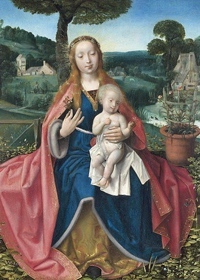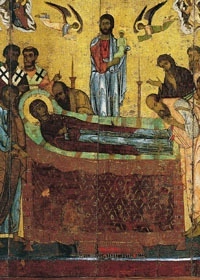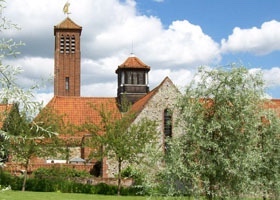
圣母的教义——童贞生子与诞神女
上主的母亲马利亚有许多尊号加身:圣马利亚(Saint Mary)、蒙福童贞女(the Blessed Virgin Mary)、蒙福圣母(the Blessed Mother)、世海之星(our Lady,主要存在于西方教会中)(译者注:该尊号的拉丁原文为「Stella Maris」,在英文中也翻译为「Star of the Sea」或「Star of the Ocean」)、新的夏娃(the New Eve)、天上母后(the Queen of Heaven),诸圣人之后(the Queen of the Saints),诸宗徒之后(the Queen of Apostles),诸为义致命之后(the Queen of Martyrs),凡此种种。根据第三次大公会议的定义,她即是「Theotokos」,这个词在西方教会中经常被翻译为「上帝之母」(Mother of God),也可以从字面上翻译为「怀道者/诞神女」(God-bearer)。在大众的敬虔中,也使用取材于引用自圣经的象征意向,还赋予了她这些尊号:结约之柜(Ark of the Covenant)、义德之镜(Mirror of Justice)、无刺玫瑰(Rose without thorns)、身披日头与星冠之母(the Woman clothed in the sun and stars)。
关于圣母的两个信条都是基于圣经确立的,并且也都是大公教会关于信仰的核心宣认的一部分。这两个信条中的第一个通常被称为「童贞产子」(Virgin Birth),虽然该信条更准确来说是关于上主是童贞女因圣灵降孕所生的教义。也就是说,上主奇妙地借由童贞女所生,却没有肉身上的生父(见《马太福音》1:18-23;《路加福音》1:26-35)。
以弗所会议(Ephesus)所定义的「怀道者/诞神女」(Theotokos)信条,是源自圣经,且是作为基于上主「真人与真神的合一」及圣母「上帝之母」(Mary’s maternity)这两个事实而得出的必然结论的。
Important Beliefs–Perpetual Virginity and the Assumption 重要信仰——永久童贞与升天
与「童贞产子」相比,其他关于圣母的信仰和教义的地位则次之,因为它们不是那么清楚地植根于圣经,也不是那么直接地与「道成肉身」和上主「真人与真神的合一」这两个核心事实相关。然而,圣母「终身童贞」(the Perpetual Virginity)这一观点,从公元五世纪起就几乎被普遍接受,虽然这不是一个信条,但即使是最权威的宗教改革者也相信这一点。「终身童贞」的教义就意味着新约中提到的上主的兄弟姐妹是涉及同父异母的兄弟姐妹(约瑟在早先婚姻时的子女)或堂兄弟姐妹或类似的近亲(这些人在圣经中通常被称为「兄弟」或「姐妹」)。
「终身童贞」也有着大公会议和教父们的支持,圣母曾被许多教父和类似的教会官方称为「永贞女」( Ever-Virgin),如第五次普世大公会议,即第二次君士坦丁堡会议(Constantinople II) (记载在本次会议的决议和敕令中),以及公元692年召开的特鲁洛会议(the Synod in Trullo)(记载在该会议的规条一,即Canon 1中)。根据著名的《利奥大卷》(Tome of Leo),圣母诞下上主的全程中是没有痛苦且童贞始终是完整的,即who bore him as she had conceived him, without loss of virginity。
This idea is also maintained by the Synod in Trullo (Canon LXXIX). The Perpetual Virginity is frequently referred to in the liturgies of the East and West, and so it has an ecumenical consensus. It also has authorized liturgical expression in the Anglican Catholic Church. Thus the Perpetual Virginity is at least a pious and godly opinion. Whether the anathema of Constantinople II refers to rejection of the Perpetual Virginity itself directly is doubtful, since the Perpetual Virginity seems to be mentioned more by the way in the course of the Council’s reaffirmation of central Christological teachings. Nevertheless, it does not seem safe to reject this ecumenical belief.
Apart from the fact of our Lord’s Virginal Conception, the earliest post-biblical Christian writers on our Lady dwelt upon her identity as the New or Second Eve. This idea extends Saint Paul’s reflections upon Christ as the new Adam, and it draws on data in Saint John’s Gospel (particularly 2:1-11 and 19:26-7, in the light of John’s Genesis theme) and in Revelation 12. Mary as the new Eve is the new ‘mother of all living’ (Genesis 3:20), whose Son and Seed bruises the head of Satan and sin by way of fulfilling the prophecy in Genesis 3:15 (the protoevangelium or First Gospel). Our Lord entrusts his Beloved Disciple to the maternal care of his mother, who is therefore the Mother of the Church.
While Protestants and Catholics sometimes have debated as to whether the woman in Revelation 12 is Mary or the Church, the distinction is false. Mary in Johannine thought is a figure for and type of the Church, and likewise the Church has a Marian quality. Revelation 12 concerns both the Church and Mary, with the Church represented by a figure who manifestly mirrors Mary. It is unfortunate if debate about our Lady divides Christians, when her roles as the new Eve and Mother of the Church not only can be universally accepted by Christians, but also are the most ancient, important, and fruitful for Christian faith and meditation.
This theme of Mary as the new Eve finds striking expression in a Marian hymn by the Non-Juring Anglican bishop, Thomas Ken (1637- 1711):
As Eve when she her fontal sin reviewed, Wept for herself and all she should include, Blest Mary with man’s Saviour in embrace Joyed for herself and for all human race.
——Her Virgin Eyes saw God Incarnate Born
Another ancient and devout belief concerning our Lady holds that at the time of her passing from this life she was taken up into heavenly glory. In the Roman Catholic Church this belief since 1950 has taken the form of the dogma of the Assumption, which holds that Mary was assumed body and soul into heavenly glory and so is buried nowhere on earth. While Eastern Orthodox Christians believe virtually the same thing, they are not inclined to be quite so precise in their terminology and definition. The Western feast of the Assumption on August 15th in the East is called the feast of the Dormition or Falling-Asleep (Koimesis) of the Theotokos. It would be very difficult to find an Anglican Catholic who does not believe that our Lady is in heavenly glory. Bishop Ken, again, gives Anglican expression to this belief:

Heaven with transcendent joys her entrance graced, Next to his throne her Son his Mother placed; And here below, now she’s of heaven possest, All generations are to call her blest.
Most Anglicans probably also believe that it does not matter very much, as Archbishop John-Charles Vockler once put it, whether Mary got to heaven ‘by the express or the local’: that she is glorified there is the important matter. In any case Roman Catholic precision in doctrinal definition sometimes tends to be excessive, and the elevation of a precisely defined Assumption to dogmatic status seems unnecessary. The Assumption first appears in orthodox Christian writers late in the sixth century. Earlier references to it come in apocryphal writings of little or no independent authority.
The positive theological value of belief in the glorification of our Lady into heaven is the assurance it offers Christians that what our Lord achieved at his Ascension – namely the glorification of human nature – is a possibility also for us. The glorification of our Lord’s humanity seems inevitable, given the union of that humanity with his divinity. But that a human being such as Mary, who is not God but merely human, can be glorified gives hope to all Christians. Mary in this respect also is a figure and prototype for the Christian and the Church.
A Subject of Debate–The Immaculate Conception A more widely debated belief, which also now is dogmatically held by the Roman Catholic Church, is the Immaculate Conception. The Immaculate Conception, defined for Roman Catholics in 1854, is a belief concerning, not our Lord’s conception by his mother, but rather Mary’s own conception by her mother. This belief holds that in virtue of our Lord’s own merits foreseen, and because of her future role as our Lord’s mother, God suppressed in Mary at the first instant of her being and conception all spot and stain of original sin. In effect God gave to Mary at the instant of her conception what he gives to all Christians by baptism. However, in our Lady this victory over original sin was combined with such grace that she continued free from actual, personal sin.
The ideas that Mary was spotless or sinless in terms of personal sin and was filled with special grace enjoy wide conciliar and patristic authority and an ecumenical consensus. However, the Immaculate Conception is not held generally in the Eastern Church and was explicitly rejected by the greatest medieval theologians in the West, including Saints Bernard, Albert the Great, Thomas Aquinas, and Bonaventure. Therefore the Roman Catholic version of the Immaculate Conception does not have ecumenical status. While Anglican Catholics are free to believe in the Immaculate Conception as a pious and devout opinion, it is neither a dogma nor a doctrine of our Church. The special preservation of Mary from sin in virtue of her role in the Incarnation, however, seems eminently fitting and godly.
Once again in this matter Mary is chiefly significant as a type and figure of the Christian. As God gives us the blessings of forgiveness of sin and newness of life, so this work of grace is abundantly and deeply realized in our Lord’s Mother as the Mother of all those who rise to the new life of grace through the merits and mediation of Christ.

Intercessor, not Mediator
Belief both in Mary’s intercession for the Church and for Christians and also in the appropriateness of requesting such intercession, is ecumenical and universal among Catholic and Orthodox Christians. From these beliefs and from Mary’s high place in the history of salvation according to the gospels come the various Marian devotions such as the Rosary, the Marian seasonal antiphons, the Litany of the Blessed Virgin Mary, and Marian shrines, whether in humble homes and parishes or in great centers of pilgrimage such as Walsingham, Lourdes, and Czestochowa.
It is, of course, essential that Marian devotion always remain anchored in devotion to our Lord. Our Lady’s place in the Incarnation and in the order of salvation as new Eve and as type of the Church ensure that all generations shall call her blessed, as she herself prophesied most truly.
Recent Roman Catholic proposals that our Lady be called the ‘mediatrix of all grace’ or ‘co-mediatrix of all grace’ are most unfortunate. These proposals introduce division, disquiet, and novelty of expression where tradition, antiquity, and ecumenical consensus should govern. It is possible that such expressions can with effort be interpreted in an orthodox and catholic sense: all Christians in a way are mediators of grace for others when we make for them prayers and intercessions that are pleasing unto God. This is true, no doubt, of our Lord’s Mother in a particularly strong sense. However, this element of truth adds nothing to the idea of the intercession of the saints and of our Lady except novel language that is ambitious of unorthodox and dangerous misinterpretation.